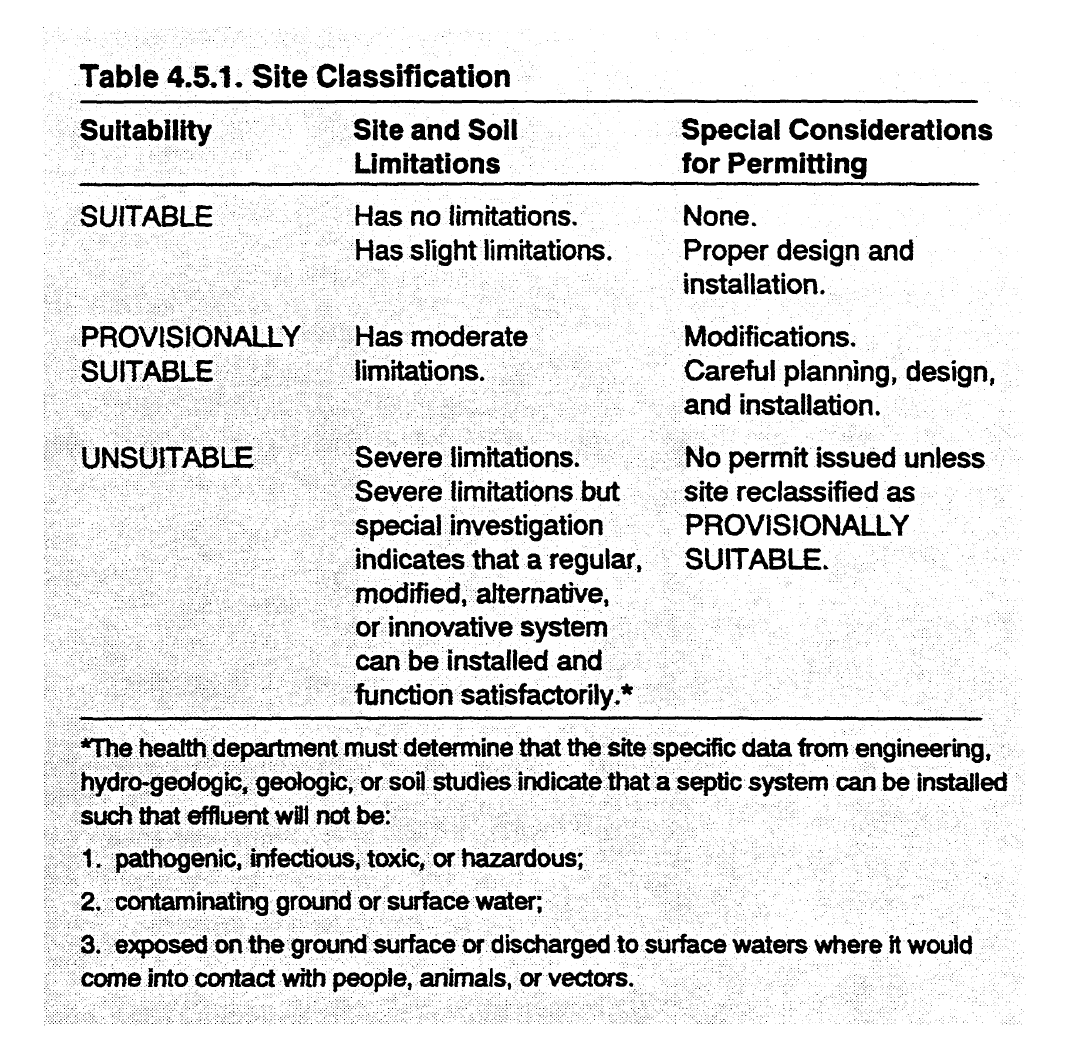Six factors must be evaluated for installation of an on-site system. These factors determine what type of on-site system best fits the site and how well the system will perform. The following section first discusses the six site and soil evaluation factors and how the site can be classified. Then each evaluation factor is presented in detail, explaining what the factor is and how to evaluate it. NOTE: This applies to design wastewater flows of 3,000 gpd or less.
In the state of North Carolina six factors must be evaluated to determine the suitability of a site for on-site system installation. The six factors are:
1. slope and landscape position,
2. soil morphological characteristics,
3. soil wetness,
4. soil depth,
5. restrictive horizons, and
6. available space.
Classification of Factors
After the site and soil evaluation, the local health department will compile the information and classify each factor as SUITABLE (S), PROVISIONALLY SUITABLE(PS), or UNSUITABLE (U), for ground absorption sewage effluent treatment and disposal (fable 4.5.1).
Overall Site Suitability
After each of the factors are classified as S, PS, or U, the overall site classification is determined by the most limiting factor that cannot be corrected by design or site modifications. For example, the soil wetness factor is U due to soil wetness at a depth of 32 inches in a loamy soil. The site may then be reclassified as PS, with the trench bottom installed no deeper than 20 inches.
Site Classification
Types of on-site systems allowed for each site classification.
A site classified as SUIT ABLE receives a permit for on-site system installation with few restrictions. A permit with more restrictions is issued for a site classified as PROVISIONALLY SUITABLE. No permit is issued for UNSUITABLE sites unless the site is reclassified as PROVISIONALLY SUIT ABLE. The three types of site classification are described in the following list.
1. A conventional on-site system can be installed on a SUIT ABLE site with greater than 4 feet to any restrictions. This system could have 2 feet of backfill over the top of the crushed rock in the trench and the trench bottom would be at least 12 inches above any unsuitable soil layer. See Figure 4.5.1 for a diagram of a conventional trench.
2. A modified on-site system would have to be installed on a site permitted as PROVISIONALLY SUIT ABLE. For example, in a conventional modified system the distance between the soil surface and top of the crushed stone in the trench would only be 12 inches instead of 24 inches. See Figure 4.5.1 for a diagram of one type of modified conventional trench.
3. If a soil layer with unsuitable characteristics is located within 36 inches of the surface, the soil is classified as UNSUITABLE. With further investigation and if certain site modifications are made or if certain alternative on-site systems are used, the site may reclassified as PROVISIONALLY SUIT ABLE. Chapter 7 gives details about alternative systems .
Placement of modified conventional trenches in the soil
Reclassifying UNSUITABLE Sites.
Sites can be reclassified from UNSUITABLE to PROVISIONALLY SUIT ABLE because of soil wetness or restrictive horizons if the following conditions are met:
1. Soils are Group I or II with SUITABLE structure and clay mineralogy.
2. Restrictive horizons, if present, are less than 3 inches thick or less than 12 inches from the soil surface.
3. Site modifications can be made so that there is at least one foot of naturally occurring soil between the trench bottom and saprolite, rock, or any soil horizon unsuitable because of structure, clay mineralogy, and wetness. A lowpressure pipe system must be used if the separation between the bottom of the nitrification trench and any soil wetness condition is less than 18 inches and if more than 6 inches of this separation consists of Group I soils.
4. Easements are recorded and have adequate width for access to maintain drainage systems serving two or more lots.
5. Maintenance of the drainage system is made a condition of any permit issued for the use or operation of a sanitary sewage system.
6. Drainage can be used in other types of soil as long as the appropriate engineering, bydrogeologic, geologic, or soil studies indicate that:
a ground absorption system can be installed so that the effluent will be non-pathogenic, non-infectious, non-toxic, and non-hazardous;
the effluent will not contaminate ground water or surface water; and
the effluent will not be exposed on the ground surface or be discharged to surface waters where it could come in contact with people, animals, or vectors.
From the North Carolina Onsite Guidance Manual


